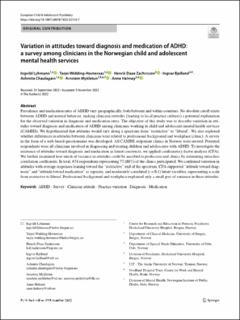| dc.contributor.author | Lyhmann, Ingvild | |
| dc.contributor.author | Widding-Havnerås, Tarjei | |
| dc.contributor.author | Zachrisson, Henrik Daae | |
| dc.contributor.author | Bjelland, Ingvar | |
| dc.contributor.author | Chaulagain, Ashmita | |
| dc.contributor.author | Mykletun, Arnstein | |
| dc.contributor.author | Halmøy, Anne | |
| dc.date.accessioned | 2022-12-21T08:25:19Z | |
| dc.date.available | 2022-12-21T08:25:19Z | |
| dc.date.created | 2022-12-03T18:35:38Z | |
| dc.date.issued | 2022 | |
| dc.identifier.issn | 1018-8827 | |
| dc.identifier.uri | https://hdl.handle.net/11250/3038950 | |
| dc.description.abstract | Prevalence and medication rates of ADHD vary geographically, both between and within countries. No absolute cutoff exists between ADHD and normal behavior, making clinician attitudes (leading to local practice cultures) a potential explanation for the observed variation in diagnosis and medication rates. The objective of this study was to describe variation in attitudes toward diagnosis and medication of ADHD among clinicians working in child and adolescent mental health services (CAMHS). We hypothesized that attitudes would vary along a spectrum from “restrictive” to “liberal”. We also explored whether differences in attitudes between clinicians were related to professional background and workplace (clinic). A survey in the form of a web-based questionnaire was developed. All CAMHS outpatient clinics in Norway were invited. Potential respondents were all clinicians involved in diagnosing and treating children and adolescents with ADHD. To investigate the existence of attitudes toward diagnosis and medication as latent constructs, we applied confirmatory factor analysis (CFA). We further examined how much of variance in attitudes could be ascribed to profession and clinics by estimating intraclass correlation coefficients. In total, 674 respondents representing 77 (88%) of the clinics participated. We confirmed variation in attitudes with average responses leaning toward the “restrictive” end of the spectrum. CFA supported “attitude toward diagnosis” and “attitude toward medication” as separate, and moderately correlated (r = 0.4) latent variables, representing a scale from restrictive to liberal. Professional background and workplace explained only a small part of variance in these attitudes. | en_US |
| dc.language.iso | eng | en_US |
| dc.publisher | Springer | en_US |
| dc.rights | Navngivelse 4.0 Internasjonal | * |
| dc.rights.uri | http://creativecommons.org/licenses/by/4.0/deed.no | * |
| dc.title | Variation in attitudes toward diagnosis and medication of ADHD: a survey among clinicians in the Norwegian child and adolescent mental health services | en_US |
| dc.type | Journal article | en_US |
| dc.type | Peer reviewed | en_US |
| dc.description.version | publishedVersion | en_US |
| dc.rights.holder | Copyright 2022 the authors | en_US |
| cristin.ispublished | true | |
| cristin.fulltext | original | |
| cristin.qualitycode | 2 | |
| dc.identifier.doi | 10.1007/s00787-022-02110-7 | |
| dc.identifier.cristin | 2088170 | |
| dc.source.journal | European Child and Adolescent Psychiatry | en_US |
| dc.identifier.citation | European Child and Adolescent Psychiatry. 2022. | en_US |

